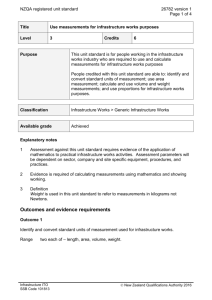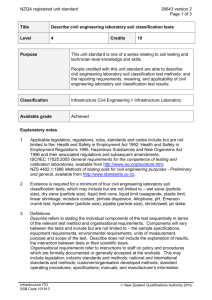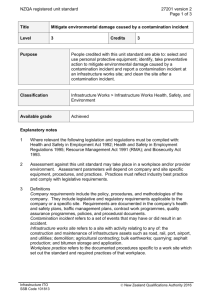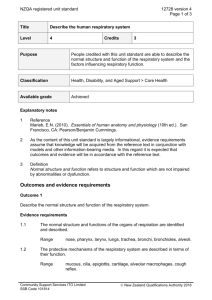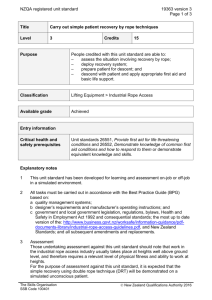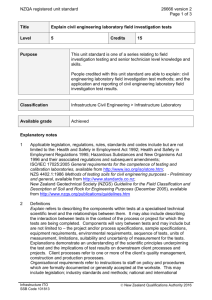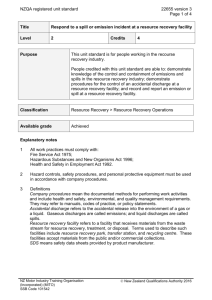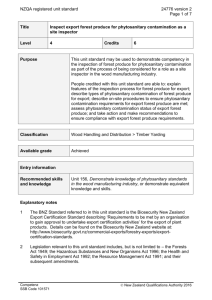27202 Demonstrate knowledge of factors relating to the
advertisement
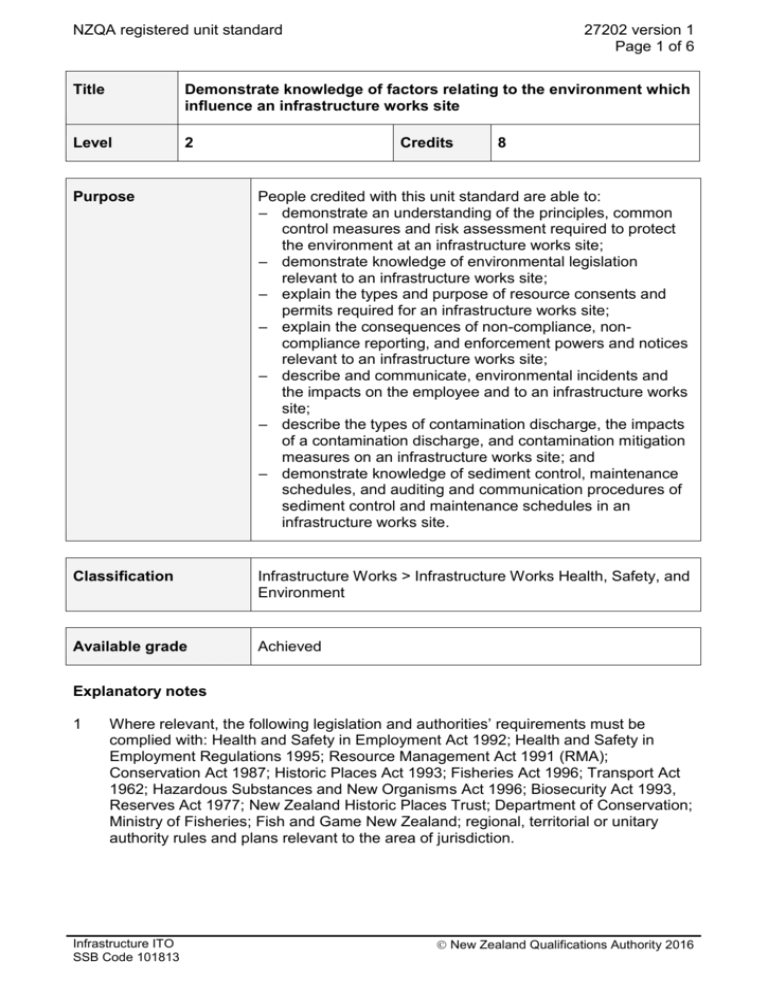
NZQA registered unit standard 27202 version 1 Page 1 of 6 Title Demonstrate knowledge of factors relating to the environment which influence an infrastructure works site Level 2 Credits 8 Purpose People credited with this unit standard are able to: – demonstrate an understanding of the principles, common control measures and risk assessment required to protect the environment at an infrastructure works site; – demonstrate knowledge of environmental legislation relevant to an infrastructure works site; – explain the types and purpose of resource consents and permits required for an infrastructure works site; – explain the consequences of non-compliance, noncompliance reporting, and enforcement powers and notices relevant to an infrastructure works site; – describe and communicate, environmental incidents and the impacts on the employee and to an infrastructure works site; – describe the types of contamination discharge, the impacts of a contamination discharge, and contamination mitigation measures on an infrastructure works site; and – demonstrate knowledge of sediment control, maintenance schedules, and auditing and communication procedures of sediment control and maintenance schedules in an infrastructure works site. Classification Infrastructure Works > Infrastructure Works Health, Safety, and Environment Available grade Achieved Explanatory notes 1 Where relevant, the following legislation and authorities’ requirements must be complied with: Health and Safety in Employment Act 1992; Health and Safety in Employment Regulations 1995; Resource Management Act 1991 (RMA); Conservation Act 1987; Historic Places Act 1993; Fisheries Act 1996; Transport Act 1962; Hazardous Substances and New Organisms Act 1996; Biosecurity Act 1993, Reserves Act 1977; New Zealand Historic Places Trust; Department of Conservation; Ministry of Fisheries; Fish and Game New Zealand; regional, territorial or unitary authority rules and plans relevant to the area of jurisdiction. Infrastructure ITO SSB Code 101813 New Zealand Qualifications Authority 2016 NZQA registered unit standard 2 27202 version 1 Page 2 of 6 Definitions Infrastructure works site refers to a site with activity relating to any of: the construction and maintenance of infrastructure assets such as road, rail, port, airport, and utilities; demolition; bulk earthworks; quarrying; asphalt production; and bitumen storage and application; Environmental aspect refers to any activity, product or service which has the potential to affect the environment; Environmental impact refers to the actual problem or consequence which results from an environmental aspect; Environmental risk assessment includes but is not limited to – identifying the likelihood that an environmental impact will occur and the magnitude of the problem if it does occur; Control measure refers to a method or procedure used to prevent, remedy or mitigate environmental impacts; Coastal marine area as defined in the RMA, means the foreshore, seabed, and coastal water, and the air space above the water: (a) of which the seaward boundary is the outer limits of the territorial sea: (b) of which the landward boundary is the line of mean high water springs, except that where that line crosses a river, the landward boundary at that point shall be whichever is the lesser of – (i) One kilometre upstream from the mouth of the river; or (ii) the point upstream that is calculated by multiplying the width of the river mouth by five; Flora and fauna refers to plant and wildlife, respectively. The indigenous plant and wildlife of a geographical region is often referred to as that region’s flora and fauna. Both are collective terms, referring to groups of plant or wildlife specific to a region or a time period; Water course refers to a channel with bed and banks within which concentrated water flows continuously or intermittently; Wāhi tapu refers to sacred sites. These are defined locally by the hapū (sub-tribe) and iwi (tribe) that are kaitiaki (guardians) for the wāhi tapu. Typically these include burial grounds and sites of historical importance to the iwi. Outcomes and evidence requirements Outcome 1 Demonstrate an understanding of the principles, common control measures and risk assessment required to protect the environment at an infrastructure works site. Evidence requirements 1.1 Principles of protecting the environment on an infrastructure works site is demonstrated in accordance with the RMA. Range Infrastructure ITO SSB Code 101813 may include but is not limited to – the concept of sustainable development, environmental and social values, Treaty of Waitangi. New Zealand Qualifications Authority 2016 NZQA registered unit standard 1.2 Potential negative environmental effects of construction activities and common control measures on the receiving environment at an infrastructure works site are identified. Range 1.3 27202 version 1 Page 3 of 6 may include but is not limited to – potential adverse effects, on-site effects, off-site effects, physical damage, discharges to air, land and water, noise (including vibration). Environmental risk assessment to the receiving environment at an infrastructure works site is carried out in accordance with the RMA. Range assessment of – immediate work area, associated activity, whole site. Outcome 2 Demonstrate knowledge of environmental legislation relevant to an infrastructure works site. Range detailed knowledge of the legislation is not required. Evidence requirements 2.1 Purpose and principles of environmental legislation relevant to an infrastructure work site are described. Range 2.2 Individual employee and employers responsibilities for compliance with environmental legislation on an infrastructure work site are explained. Range 2.3 RMA, Conservation Act 1987, Historic Places Act 1993, Fisheries Act 1996, Transport Act 1962, Hazardous Substances and New Organism Act 1996, Biosecurity Act 1993, Reserves Act 1977. RMA, Conservation Act 1987, Historic Places Act 1993, Fisheries Act 1996, Transport Act 1962, Hazardous Substances and New Organism Act 1996, Biosecurity Act 1993, Reserves Act 1977. Administration authorities responsible for enforcement of the range of legislation relevant to an infrastructure work site are explained. Range Consent Authorities, Department of Conservation, Ministry of Fisheries, Historic Places Trust, Fish and Game New Zealand. Outcome 3 Explain the types and purpose of resource consents and permits required for an infrastructure works site. Infrastructure ITO SSB Code 101813 New Zealand Qualifications Authority 2016 NZQA registered unit standard 27202 version 1 Page 4 of 6 Evidence requirements 3.1 Types and purpose of permits and consents required for an infrastructure works site are explained. Range land use consent, subdivision consent, coastal permit, water permit, discharge permit, purpose, classes of activities, terms, conditions. Outcome 4 Explain the consequences of non-compliance, non-compliance reporting, and enforcement powers and notices relevant to an infrastructure works site. Evidence requirements 4.1 The consequences of non-compliance and non-compliance reporting relevant to an infrastructure works site are explained. Range 4.2 reputation of employer (environmental attributes and safety record), financial consequences, environmental risks, penalties for offences. Enforcement powers and notices relevant to an infrastructure works site are explained. Range includes not is not limited to – abatement notice local authority enforcement officer issued directive, laying of information (administering authority takes prosecution), infringement notice, powers of enforcement agents. Outcome 5 Describe and communicate environmental incidents and the impacts on the employee and to an infrastructure works site. Evidence requirements 5.1 Environmental incidents at an infrastructure works site are described, and the impacts on the employee and the worksite are clarified in accordance with workplace practice. Range 5.2 evidence of three hazards. Environmental incidents at an infrastructure works site are communicated by the employee to fellow workers, employees’ immediate supervisor on-site.in accordance with workplace practice. Outcome 6 Describe the types of contamination discharge, the impacts of a contamination discharge, and contamination mitigation measures on an infrastructure works site. Infrastructure ITO SSB Code 101813 New Zealand Qualifications Authority 2016 NZQA registered unit standard 27202 version 1 Page 5 of 6 Evidence requirements 6.1 Types of discharge and potential contaminants on an infrastructure works site are described in accordance with workplace practice. Range 6.2 The impacts of a contamination discharge from an infrastructure works site are described in accordance with the work site environmental plan and workplace practice. Range 6.3 types of discharge may include but is not limited to – discharge to air, discharge to water, discharge to land; potential contaminants may include – dirt, milk, hot water, concrete, concrete cutting, fuel, fuel storage, hydraulic fluids, chemicals, chemical storage, asphalt and emulsion, atmospheric conditions, dust, odour/emissions, washing wastes, cesspits, storm water retention basins; evidence of twelve types of discharge and/or potential contaminants required. may include but is not limited to impacts of – discharge into adjourning properties/boundaries/wider community and waterways; may include but is not limited to impacts on – soils, vegetation, atmosphere, dust, tracking, vehicles and equipment, employees and fellow workers, work site visitors, residents; evidence of nine impacts required. Contamination control and/or mitigation measures on an infrastructure works site are described in accordance with the work site environmental plan and workplace practice. Range evidence of three contamination control and/or mitigation measures. Outcome 7 Demonstrate knowledge of sediment control, maintenance schedules, and auditing and communication procedures of sediment control and maintenance schedules in an infrastructure works site. Evidence requirements 7.1 Sediment control, maintenance schedule and auditing procedures are described in accordance with workplace practice. Range Infrastructure ITO SSB Code 101813 may include but is not limited to – visual checks. New Zealand Qualifications Authority 2016 NZQA registered unit standard 7.2 27202 version 1 Page 6 of 6 Sediment control and maintenance schedule are communicated to employees, immediate supervisor on an infrastructure work site in accordance with workplace practice. Range existing controls, damage avoidance, reinstatement. Planned review date 31 December 2015 Status information and last date for assessment for superseded versions Process Version Date Last Date for Assessment Registration 1 17 June 2011 N/A Consent and Moderation Requirements (CMR) reference 0101 This CMR can be accessed at http://www.nzqa.govt.nz/framework/search/index.do. Please note Providers must be granted consent to assess against standards (accredited) by NZQA, before they can report credits from assessment against unit standards or deliver courses of study leading to that assessment. Industry Training Organisations must be granted consent to assess against standards by NZQA before they can register credits from assessment against unit standards. Providers and Industry Training Organisations, which have been granted consent and which are assessing against unit standards must engage with the moderation system that applies to those standards. Requirements for consent to assess and an outline of the moderation system that applies to this standard are outlined in the Consent and Moderation Requirements (CMRs). The CMR also includes useful information about special requirements for organisations wishing to develop education and training programmes, such as minimum qualifications for tutors and assessors, and special resource requirements. Comments on this unit standard Please contact Infrastructure ITO askus@infratrain.co.nz if you wish to suggest changes to the content of this unit standard. Infrastructure ITO SSB Code 101813 New Zealand Qualifications Authority 2016

